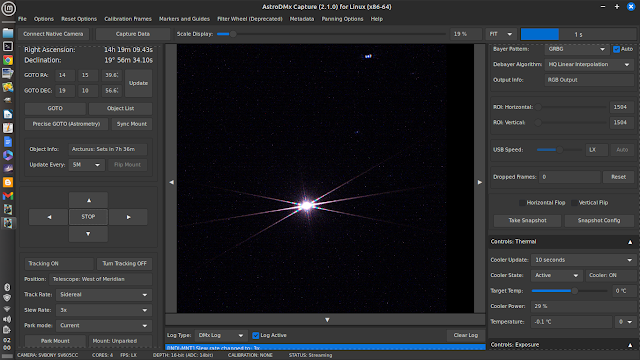The SV605CC was fitted with a 1.25” nosepiece and an SVBONY UV/IR cut filter. The camera was fitted directly into the visual back without the use of a diagonal. This gave a very firm grip on the camera which was held firmly in place by the two substantial thumb screws. The Skymax 127 Maksutov was motor focus modified to give very fine control over focusing.
Auto-guiding was done by PHD2 running on a separate computer using an SVBONY SV165 guide-scope fitted with a QHY-5II-M guide camera.
As usual, the mount was placed on marks on the concrete base which give a fairly good polar alignment. AstroDMx Capture passed the time, altitude and location coordinates to the hand controller via the INDI server. The hand controller which now contained all of the correct information was set to its previous alignment and was unparked by AstroDMx Capture.
The equipment
AstroDMx Capture was used to send the scope/mount to Arcturus to check focus with a Bahtinov mask.
At this stage it was necessary to start auto-guiding even though the scope just missed Arcturus as expected. The reason is that it is necessary to plate-solve in order to centre Arcturus. Due to the long focal length of the scope, plate-solving is commensurately more difficult as at least 30 stars, some as low as mag 16, are required by ASTAP to be in the limited field of view in order to plate-solve; preferably more. A two minute exposure was used in order to capture sufficient stars. This is why autoguiding is required at this stage as even slightly trailed stars will not enable successful plate-solving. After a successful plate-solve, Arcturus was placed near the centre of the field of view and focus could be checked by using a Bahtinov mask.
A Bahtinov mask on the front of the Maksutov
The mount/scope was then sent to M3 by AstroDMx Capture, plate-solved and M3 was centred in the field of view.
AstroDMx Capture was used to capture 30 x 2 minute FITS exposures of M3
Dark frames and Flat fields were also captured
A variable light illuminated tracing box was used along with a white plasticard filter to capture flat fields.
AstroDMx Capture capturing Flat fields
Stacked median flat field
This image shows the importance of capturing flats.
The FITS images of M3 were calibrated, registered and stacked in Siril. Although it is possible to do processing and background extraction in Siril, it was decided to use GraXpert to stretch and background extract the stacked M3 image in one operation.
GraXpert sampling the background
GraXpert showing the original stretched image with a gradient due to a nearby street light.
GraXpert showing the extracted background
GraXpert showing the background corrected, stretched image
The background corrected, stretched image was then post processed in the Gimp and Neat Image.
M3
When using a Maksutov Cassegrain or a Schmidt Cassegrain telescope the exact focal length of the scope can vary depending on how far the mirror has to be moved to achieve focus. With the small fields of view involved here, this can impact the actual field of view, and therefore the probability of a successful plate-solve. We determined the field of view and therefore the focal length of the scope in our configuration by doing a blind plate-solve on a captured image using Astrometry.net. We were then able to enter the correct focal length into AstroDMx Capture’s ASTAP plate solver and achieve reliable plate solving.
Nicola intends to implement a mode in AstroDMx Capture that will take longer to solve, but which will be able to tolerate small inaccuracies in the focal length and field of view.











